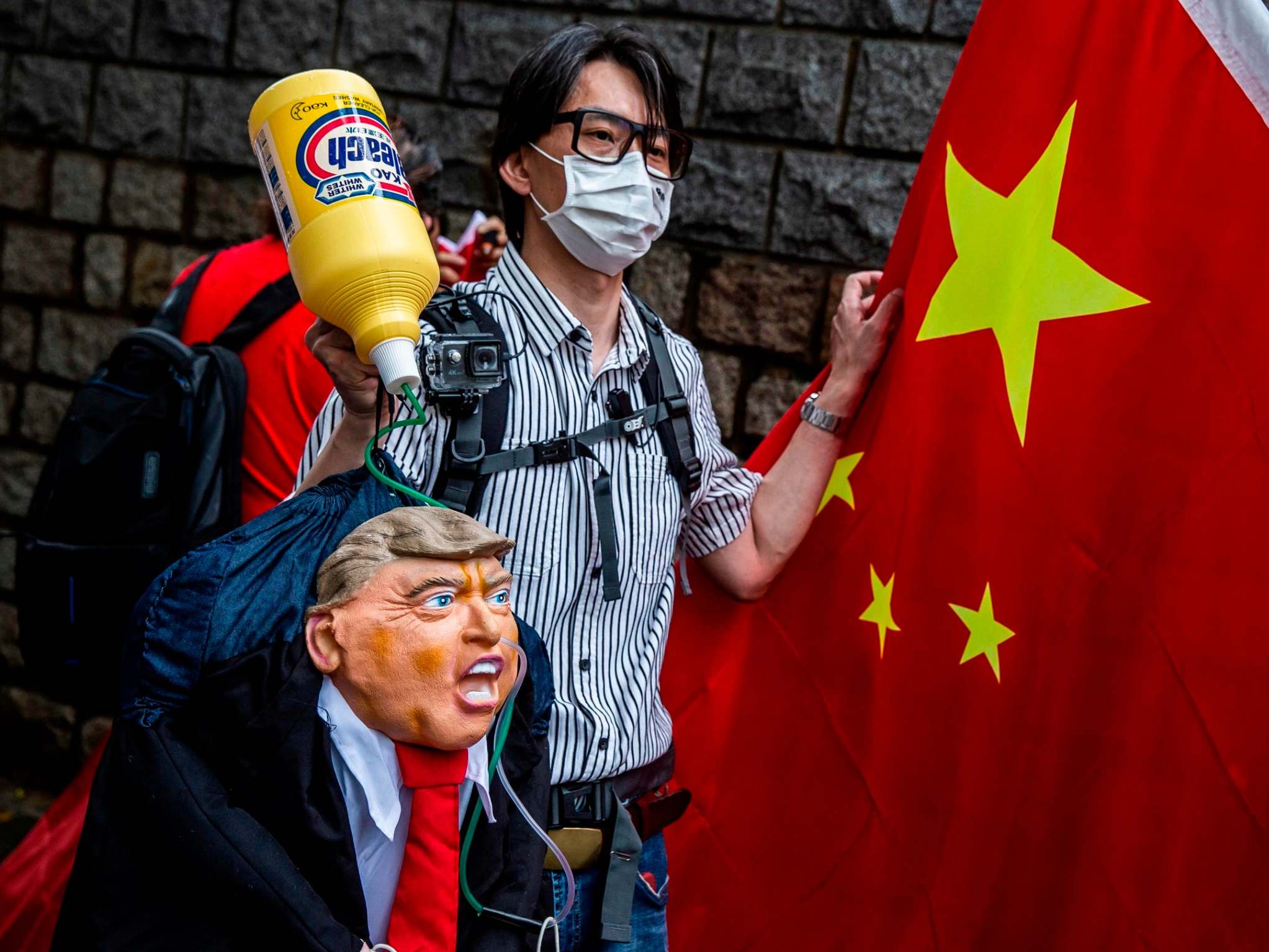The burning anger across America is pushing Trump closer to a cold war with China
Beijing has taken great glee in pointing out the US reaction to the George Floyd protests in comparison to how those in Hong Kong were met, writes Kim Sengupta


From calling the protests in Minneapolis “a beautiful sight to behold”, to warning Donald Trump “not to hide” and using the phrase “I can’t breathe”, the messages being pushed in China’s media by government officials and supporters gleefully taunt the US condemnation of Beijing over demonstrations in Hong Kong as violent strife spread across America.
The editor of the Chinese Communist Party mouthpiece, the Global Times newspaper, reminded its readers that Nancy Pelosi, House of Representatives speaker, described the pro-democracy marches in Hong Kong as a “beautiful sight” adding “US politicians now can enjoy this sight from their own windows”. Hu Xijn, editor-in-chief of the Global Times, also advised the US president: “Don’t go hide behind the secret service... go to talk to the demonstrators, negotiate... just like you urged Beijing to talk to Hong Kong rioters.”
“I can’t breathe” – the words of the dying George Floyd as a policeman knelt on his neck – was posted by China’s foreign ministry spokeswoman over a screenshot of a tweet from her US state department counterpart, Morgan Ortag, about events in Hong Kong.
The outpouring of anger which has unfolded following the killing came as President Trump was laying out his latest plan as part of his campaign against China. They follow his warning of retaliation after charging Beijing with hiding the initial spread of coronavirus – something Beijing denies – and then the imposition of laws stripping Hong Kong’s autonomy.
Trump has announced Hong Kong will no longer be granted special status on trade, a move which will damage its position as one of the world’s financial hubs, and that some officials will face sanctions. He has also stated that Chinese nationals viewed as security risks will be barred from the US to safeguard intellectual property in university research.
Trump has also postponed a G7 summit he was due to host in June to September. The purported reason is that a number of international leaders, led by Angela Merkel, have said that a face-to-face meeting was too risky at this time of contagion.
The president has declared that the September meeting in Camp David will be expanded into a G11, with invitations to Russia, Australia, India and South Korea. This has been widely interpreted as an attempt to build an anti-China coalition and will undoubtedly lead to protests from Beijing.
The timing of the summit, just two months before the US presidential election, is opportune for Trump, with his campaign seemingly having decided to present China as an outside enemy to the electorate, with the added stinger of claiming that the Democrats are soft on Beijing. This is not a straightforward task – Trump has publicly praised President Xi Jinping and his government no fewer than 15 times over their handling of the coronavirus crisis – even as reports were emerging of the disease spreading from China around the world, including the US.
Australia, South Korea and India, along with Japan, a G7 member, have long been mooted as democratic counterweights to China in Asia and, as such, were part of Barack Obama’s projected “pivot to Asia” before the then-president got sucked back into the Middle East crisis with the rise of Isis.
Russia was expelled from the G7 after the annexation of Crimea in 2014. Trump, who the Kremlin wanted in the White House, has been calling for Moscow’s readmission from the first days of his presidency.
But there are other factors at play here. Russia, with its enormous territories in the east, is also an Asian power and its relationship with China, relatively strong at present, has faced strain in the past. Border clashes in 1969 over control of islands in the Ussuri river led to up to 800 Chinese soldiers being killed and the deaths of dozens of Soviet troops too. China was also among the countries supplying weapons to the mujahideen fighting Russian forces which intervened in Afghanistan in 1979.
Richard Nixon and Henry Kissinger had actively sowed divisions between China and Russia. Now, as the American analyst and writer, Parag Khanna, points out, the time may have come for the US and also the European Union to try and detach Russia from a relationship with China which is weighed heavily in Beijing’s favour demographically and has military strength in the area.
Seven former British foreign secretaries have called for an alliance over Hong Kong. They have written to Boris Johnson saying this country should be seen to lead the international response over its former colony. But Jeremy Hunt, David Miliband, Jack Straw, William Hague, Malcolm Rifkind, David Owen, and Margaret Beckett are seeking the establishment of an international contact group – like the one set up in 1984 to end the Yugoslav conflict – rather than the more combative coalition the Trump administration appears to have in mind.
The UK’s scope of action is limited. The desperate search for post-Brexit trade has made it one of very few countries in the west to get involved in China’s ‘belt and road’ scheme, an infrastructure programme which has been used to spread Beijing’s economic and political hegemony. It is the only major western state to allow the Chinese telecoms company, Huawei, into their 5G network – a decision taken against the strong opposition of the US, and other allies like Australia, a partner in the “Five Eyes” group of intelligence-sharing countries.
China has threatened retribution if the Huawei decision is reversed. The UK receives more investment from the country than any other European state and China is the UK’s third largest export market. There has also been strong reaction in Beijing to criticism in London over Hong Kong and Britain’s decision to relax rules around the ability of those holding British National (Overseas) passports to work and study in this country. A step, said foreign secretary Dominic Raab, that will offer a “path to citizenship”.
China warned that “provocative” moves by the UK will bring inevitable “countermeasures”. In fact Beijing’s response to criticism over coronavirus, the punitive measures against its Uighur Muslim population, Hong Kong human rights, or territorial disputes, have been pointedly belligerent.
Xi Jinping last week ordered the country’s armed forces to “comprehensively strengthen the training of troops and prepare for war” and “resolutely safeguard national sovereignty”. At the same time one of the country’s most senior commanders, General Li Zuocheng, warned that military action may be needed against Taiwan if it continues to refuse the acceptance of Chinese suzerainty.
This could perhaps be written off as tough rhetoric for tough times. But there have also been violent confrontations. A Chinese ship rammed a Vietnamese ship, sinking it, in disputed waters of the South China Sea. A standoff between Chinese and Malaysian vessels drew in warships from China, but also the US and Australia.
The latest, and potentially most combustible, confrontation has been between Chinese and Indian forces in the Himalayan frontier between the two countries. A series of pushing and shoving and stone-throwing clashes have led to Beijing sending large-scale reinforcement, followed by Delhi doing the same. More than 10,000 Chinese troops – according to some Indian media reports – are on Indian soil and may try to seize a disputed area, the Galwan valley.
With tension rising, Mark Esper, the US defence secretary, was told last Friday by his Indian counterpart, Rajnath Singh, that India and China would settle the matter bilaterally. Yet a few hours later Trump was announcing: “They have a big conflict going with India and China. Two countries with very powerful militaries. And India is not happy, and probably China is not happy. But I can tell you, I did speak to Prime Minister Modi – he’s not in a good mood about what’s going on with China.”
The US president said he had been asked to urgently mediate by the Indian prime minister, Narendra Modi. It seemed the situation really was escalating rapidly. Except, there is the Trump factor. Mystified Indian foreign ministry officials pointed out that Trump and the Indian prime minister had not spoken to each other since the US president visited India in late February.
But there were already warnings coming from Beijing. The Global Times warned: “India needs to be careful not to include the US factor in its handling of any problems in its relations with China... China and India have the ability to resolve their problems.
“If in a new cold war, India leans towards the US or becomes a US pawn in attacking China, the economic ties between the two neighbours will suffer a devastating blow... It would be too much for the Indian economy to take such a hit at the current stage.”
While mocking what they see as US hypocrisy over Hong Kong, Chinese officials want to stress that they had not supported violence by the protesters in America. Indeed the voluble Hu Xijn hoped that what is happening may lead to solidarity – not between protestors but the two governments. “Burning police stations, blocking roads, smashing shops, and destroying public facilities in Minneapolis and other places are exactly the same violence in the Hong Kong demonstrations,” he wanted to stress.
It is true that during his time of tendresse with Xi Jinping, Trump had been markedly slow to condemn Beijing’s crackdown in Hong Kong. And there is a chance that if he wins the presidential election in November, Trump, known for his flip-flops, may tone down his campaign against China.
But the likelihood at the moment is that a long, hot spring in the US is likely to be followed by a cold war with China.
Join our commenting forum
Join thought-provoking conversations, follow other Independent readers and see their replies
Comments